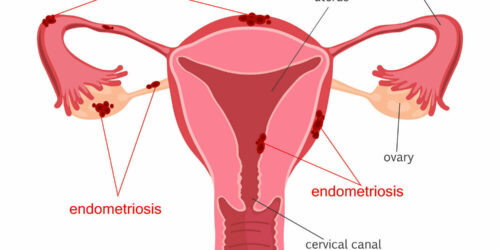Inflammation and oxidative stress are one of the common denominators of endometriosis and Polycystic Ovary Syndrome. Lifestyle and type of diet play an important role in the pathophysiology of both conditions.
Endometriosis is a complex syndrome characterized by a chronic estrogen-dependent inflammatory process, which mainly affects the pelvic tissues, including the ovaries. In the vast majority of cases, it occurs when the shed endometrial tissue travels, through a retrograde movement, towards the lower abdominal cavity. However, this disease can also affect the bladder, intestine (especially the rectum and appendix), deep pelvic nerves, ureters, anterior abdominal wall, abdominal skin, diaphragm, pleura, lungs, pericardium and the brain. Endometriosis is the most common cause of chronic pelvic pain in women and is estimated to affect between 6% and 10% of women of reproductive age. In this sense, the social, professional, academic and economic potential of young women is altered, causing anxiety, depression and affecting the potential of current or future fertility. Specifically, an excess of estrogenic hormones leads to an aggravation of symptoms, since an increase in estrogen results guide in an increase in the release of histamine into the bloodstream.
Polycystic Ovarian Syndrome (PCOS) affects between 15% and 18% of women of reproductive age, representing the most common endocrine-metabolic disorder in women of reproductive age. The present condition is defined by a combination of signs and symptoms of androgen hormone excess and ovarian dysfunction in the absence of other specific diagnoses. There are currently four recognized phenotypes of PCOS, each with different long-term health and metabolic implications. However, in most cases, these are associated with a chronic low-grade inflammation state. PCOS is frequently associated with abdominal adiposity, insulin resistance, obesity, metabolic disorders, cardiovascular risk factors, and infertility. The etiology of this syndrome remains largely unknown, although mounting evidence suggests that PCOS could be a complex multifactorial disorder with strong epigenetic and environmental influences, including lifestyle factors.
Recent studies have shown that inflammation, together with oxidative stress, is one of the common denominators of endometriosis and PCOS. For this reason, lifestyle and type of diet play an important role in both conditions. A diet that contributes to reducing this state of inflammation will reduce the excess of estrogens and androgens present in endometriosis and PCOS, respectively.
Thus, following an anti-inflammatory style diet, such as the low-histamine diet, could be one of the different therapeutic strategies to help reduce systemic inflammation. At the same time, it is important to consider other aspects which influence this condition, such as the promotion of healthy adipose tissue, the practice of physical exercise and proper management of emotions. For this reason, it is important to go to specialized professionals who assess the case and context to personalize the recommendations, both for lifestyle and diet.
If you want us to advise you in a personalized way, either in our Barcelona nutrition centre or by video conference from anywhere in the world, contact us and we will help you
Bibliography
Azziz R. (2018). Polycystic Ovary Syndrome. Obstetrics and gynecology, 132(2), 321–336. https://doi.org/10.1097/AOG.0000000000002698
Bulun, S. E., Yilmaz, B. D., Sison, C., Miyazaki, K., Bernardi, L., Liu, S., Kohlmeier, A., Yin, P., Milad, M., & Wei, J. (2019). Endometriosis. Endocrine reviews, 40(4), 1048–1079. https://doi.org/10.1210/er.2018-00242
Escobar-Morreale H. F. (2018). Polycystic ovary syndrome: definition, aetiology, diagnosis and treatment. Nature reviews. Endocrinology, 14(5), 270–284. https://doi.org/10.1038/nrendo.2018.24
Patel S. (2018). Polycystic ovary syndrome (PCOS), an inflammatory, systemic, lifestyle endocrinopathy. The Journal of steroid biochemistry and molecular biology, 182, 27–36. https://doi.org/10.1016/j.jsbmb.2018.04.008
Samimi, M., Pourhanifeh, M. H., Mehdizadehkashi, A., Eftekhar, T., & Asemi, Z. (2019). The role of inflammation, oxidative stress, angiogenesis, and apoptosis in the pathophysiology of endometriosis: Basic science and new insights based on gene expression. Journal of cellular physiology, 234(11), 19384–19392. https://doi.org/10.1002/jcp.28666
Saunders, P., & Horne, A. W. (2021). Endometriosis: Etiology, pathobiology, and therapeutic prospects. Cell, 184(11), 2807–2824. https://doi.org/10.1016/j.cell.2021.04.041
Szczuko, M., Kikut, J., Szczuko, U., Szydłowska, I., Nawrocka-Rutkowska, J., Ziętek, M., Verbanac, D., & Saso, L. (2021). Nutrition Strategy and Life Style in Polycystic Ovary Syndrome-Narrative Review. Nutrients, 13(7), 2452. https://doi.org/10.3390/nu13072452






